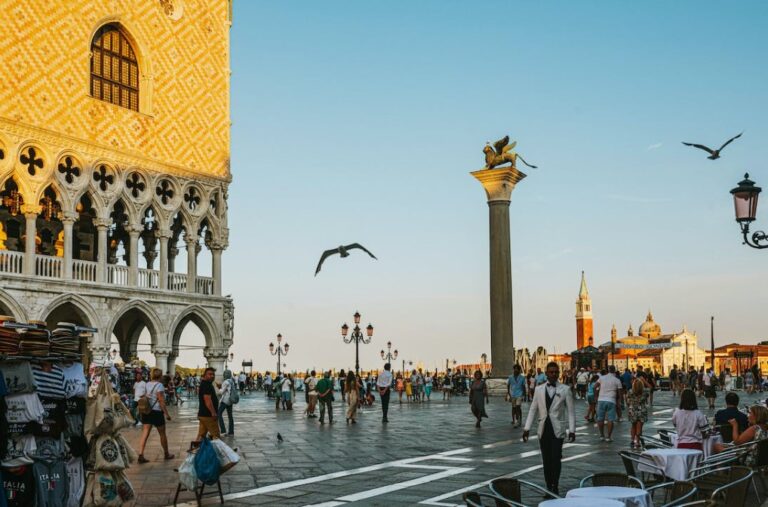UNESCO stands for the United Nations Educational, Scientific and Cultural Organization. Its main goal? To promote peace and understanding between countries through education, culture, and science. One of UNESCO’s big tasks is to point out special places around the world.
These are called World Heritage Sites. Why are they important? These sites are unique. They tell a story about our world’s history, nature, and cultures. By marking them, UNESCO helps to protect and honor them for everyone to enjoy and learn from. It’s like a global way of saying, “This place matters.”
Table of Contents
The countries with a high number of UNESCO World Heritage Sites
These are the countries with the most UNESCO World Heritage Sites:
1. Italy
Italy is top of the list with 58 UNESCO World Heritage Sites. That’s a big deal when you think about the 1,157 sites around the world. Famous places like the Piazza del Duomo in Florence, Rome’s historic center, and Venice grab a lot of attention. People from all corners visit them every year.
But Italy offers even more. Ever heard of the Dolomites mountains? They’re on the list too. The city of Verona, where a famous love story of two star-crossed lovers took place, is also a proud member. Mount Etna, always ready to rumble, is a recognized site as well.
For wine lovers, the landscape of Piedmont is a treat. It’s where delicious wines like Barolo come from. Imagine cycling there, with vineyards all around. Plus, there are spots like the unique houses in Alberobello and ancient drawings in Valcamonica that are worth a peek.
2. China
China is close behind Italy with 56 UNESCO spots. Most people think of the Great Wall when they hear “China.” But the country hides many other gems.
Take the Honghe Hani Rice Terraces. They cover a massive 16,603 hectares in Southern Yunnan. The Hani people have worked for over 1,300 years, turning mountains into beautiful terraced fields. It’s amazing to see the mist rise over them.
Then there’s the Silk Road, which tells tales of trade from over 2,000 years ago. And if you’re into philosophy, the city of Qufu is home to the temple, mansion, and cemetery of Confucius.
Last but not least, the Fujian Tulou. These are unique buildings in Fujian, built in circles or squares. They’re big – some can house up to 800 people. Built for safety, each has only one way in. And while they look simple outside, inside, they’re full of details. They’re a perfect example of Feng Shui, blending into the beautiful mountain landscape.
3. Germany
Germany boasts 51 UNESCO World Heritage Sites. One of the famous ones is the Bauhaus School’s sites in Weimar and Dessau. They stand out because Bauhaus changed art and design in the 20th century.
Another must-see is the Cologne Cathedral. It’s a grand Gothic building that took 632 years to finish. Talk about patience! And in Kassel, there’s the Hercules monument and water features in the Bergpark Wilhelmshöhe park. A feast for the eyes.
The Wadden Sea is a natural wonder. It’s a big stretch of sand and mud flats, touching the Dutch, German, and Danish North Sea coasts. It’s the largest of its kind in the world! You can find cool animals there, like grey seals and harbor porpoises.
And if you’re into history, the Messel Pit fossil site is a must-visit. It tells tales about how early mammals evolved.
4. Spain
Spain shines with 49 UNESCO sites. Barcelona, for many, is all about Antoni Gaudí’s strange and wonderful buildings. UNESCO celebrates his work for changing modern architecture.
But there’s more in Spain than just Barcelona. For example, the pilgrimage site of Santiago de Compostela. Or the canyons of Mont Perdu in the Pyrénées. Breathtaking.
A lesser-known treasure is Las Médulas. Long ago, the Romans dug there for gold, leaving behind a unique landscape.
Ibiza isn’t just for partying. It has a UNESCO status, too, but not for its clubs. It’s recognized for its marine and coastal wonders. There’s a special seagrass found only in the Mediterranean. This grass is home to many sea creatures.
5. France
France has 49 UNESCO World Heritage Sites. That’s just one less than 50! They’re tied in fourth place with Spain.
Paris, the capital, has some famous spots. Think of the River Seine’s banks or the Notre Dame Cathedral. But moving out from Paris, there are other wonders. Mont Saint-Michel is one. It’s a tall Gothic abbey that looks like it’s out of a fairy tale. Then there are the Champagne hillsides, where the famous bubbly drink comes from.
If you love nature, the Gulf of Porto is a must-see. It’s in Corsica’s natural park. It’s known for its scrubland and clear blue waters. Many sea birds like seagulls and sea eagles enjoy it there too.
6. India
India is home to 40 UNESCO sites. In 1983, a special landmark made it to the list: the Taj Mahal in Agra. It’s not just a World Heritage Site. Many see it as one of the modern Seven Wonders of the World. Close by, there’s the Red Fort of Agra. It’s a big, old fortress that also got the UNESCO nod in the same year.
Away from Agra, about 1,000km away, are the Ajanta Caves. They are old, starting from the first and second century BC. Some of the caves are beautifully decorated. They show some of the best Buddhist art in the world.
India’s list has 32 cultural spots. And seven natural ones. One of these is Kaziranga National Park in Assam. It’s wild and big. And it’s special because of a unique animal: the one-horned rhinoceros. They live there happily.
Read also: The world’s most visited cities in 2023: the ranking












